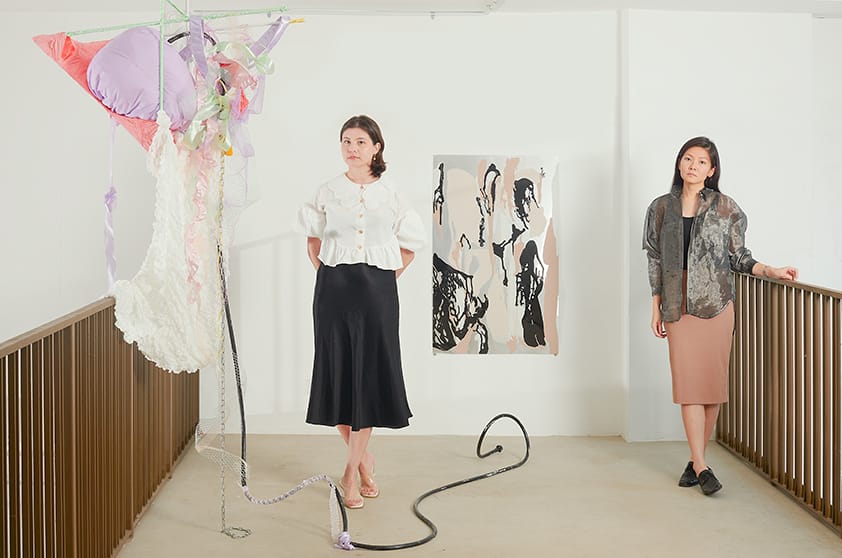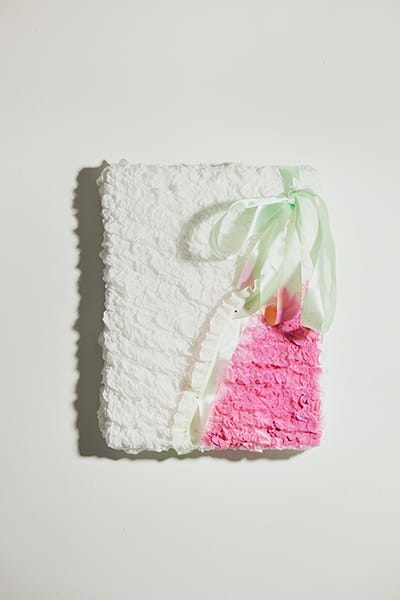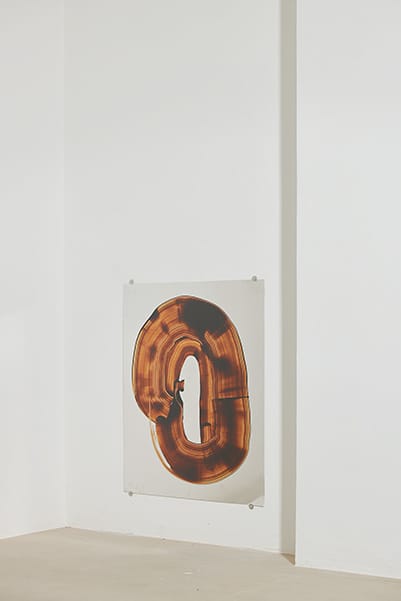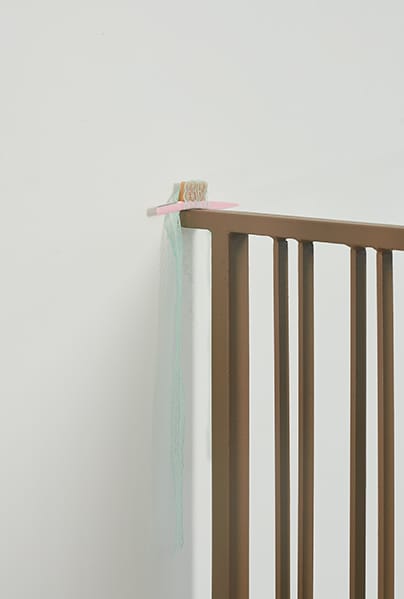
Lather & Pave is a joint exhibition by artists Joanne Pang and Stephanie Jane Burt. At a glance, it presented works with forms that were distinctly recognisable to each artist — Burt’s delicate but larger than life structure dressed in ribbon and lace, suspended from poles accompanied by other smaller paintings or sculptural objects; Pang’s installation observed the use of objects alongside abstract paintings on shiny aluminium surfaces.
Looking closer, it became clear that the works were bound to one another through a shared narrative. Inquiring into the nature of rest and what it entails, the artists dwelled into the mundane nature of cleaning as a form of resistance — an idea that has been associated with patriarchal, classist viewpoints that place the act of cleaning at the margins. In coming to the materiality and form of their works, they also reflected on living conditions (“how we are living in an urban environment, fast-paced and quite stressful,” both explain).
—

Pang’s and Burt’s works seemed to touch on the prescription of responsibilities and performativity of labour. They lend thought to questions such as, what comes to mind at the mention of ‘cleaning’? What role does cleaning play in our society and the household? How do we regard the person performing the chore? Have house chores been excessively imposed on women?
Conceptually, Lather & Pave pondered upon gestures of care and how labour is perceived. Attempting to revisit the phrase “a woman’s work is never done”, the artists relooked at the notion of house chores rendering common cleaning tools into non-functional items — defying the seemingly never ending routine of housework into an immobile cycle. The exhibition also explored the tension and relationship of dualities between space (indoor versus outdoor), nature (natural versus man-made), qualities (soft versus hard) and attachment (closeness versus detachment). This dialogue was observed through their use of sensual, soft and industrial materials.
—
What led to the actualisation of Lather & Pave was a poem by Francis Ponge, meticulously titled “Soap”. Ponge’s expression about the many ways soap changes while using it bred curiosity in Burt about this shape and she created a few paintings where the soap bar remained at a standstill. For her installation, she created a mock ironing board suspended with lace, ribbon and chains entangling and spilling out of the structure. “The weight of the fabric pulls over the structure as it hovers over a railing, threatening to give way. These points of tension have always been present in my practice,” shares Burt.
—

Pang’s installation, “At Least Once a Week” referenced the weight of water in the pail and how cumbersome it feels to move it around when mopping the floor (“I was thinking about the directions of movement and how gravity plays a part in cleaning, specifically in the process of soaking, staining and mopping,” explains Pang). Her installation symbolised the notion of load and purity of water with the heaviness and toxicity of asphalt — generally used for surfacing roads, flooring and roofing. Using seven tiles of asphalt to represent the number of days in a week, she placed the pail with a mop on the tiles to carry a sense of place and time. Her paintings, on the other hand, explored the unintentional nature of stains. “I use bitumen, soap and water to create marks that were left to evaporate on the shiny aluminium surface, creating a dialogue between chance and control, nature versus man-made,” describes Pang.
—
Individually, Pang’s practice deals with the relationship of memory, body and space while Burt centres gender, representations of femininity and girl culture. While these points of interest may seem independent from one another, perhaps what brought them together were perceptibility and the human experience. The duo shared a common interest in the materiality and multilayered nature of cleaning — both physically and mentally — and how the labour of cleaning creates a new rhythm to life, shaping everyday behaviour, perception and tolerance to the immediate environment.
“As we clean, we negotiate with time and often with the intention of reverting the state of things back to the ‘original’ or ‘clean’ condition, which also often meant negotiating with the idea of standards and measure of perfection,” Pang explains.
—

Following these lines of thought, Lather & Pave brought to mind the circular motions of cleaning. The body bears the labour of these movements, which one grows increasingly conscious of as one becomes more engaged with it. It is not an uncommon tendency to view household chores through a gendered lens. With their exhibition, Pang and Burt placed the act of cleaning or washing at the centre — allowing the viewer to renegotiate their perceptions of such labour while navigating their relationships with gestures and objects that comprise these everyday activities.
—

This story about Lather & Pave first appeared in the March 2021 issue of Men’s Folio Singapore.








